2. 中国地质大学,北京 100083
2. China University of Geosciences, Beijing 100083, China
青藏高原拉萨地体南部的冈底斯带位于雅鲁藏布缝合带(YZSZ) 和班公湖-怒江缝合带(BNSZ) 之间,东西长约2500km,南北宽100~300km,是青藏高原岩浆活动期次最多、规模最大和岩浆岩类型最复杂的构造-岩浆岩带(Yin and Harrison, 2000;潘桂棠等,2006;莫宣学等, 2003, 2009)。该带西部与印度、巴基斯坦的拉达克(Ladakh)、科希斯坦(Kohistan) 相连,向东绕过雅鲁藏布江大拐弯处的南迦巴瓦构造结(Namche Barwa Syntaxis) 呈近南北向,进入缅甸北部。
冈底斯岩浆岩带作为青藏高原的重要组成部分,一直是地学界的研究热点。近年来,许多学者对冈底斯带中、新生代岩浆活动及成因做了大量的研究,结果表明,西藏冈底斯带晚白垩纪-古近纪时期发生了大规模岩浆活动及岩浆混合作用(Xu et al., 1985;江万等,1999;Mo et al., 2005, 2007;Chu et al., 2006;潘桂棠等,2006;莫宣学等,2009;Dong et al., 2005;董国臣等,2006;Ravikant et al., 2009;Ji et al., 2009;朱弟成等, 2006, 2008, 2009)。虽然不同学者先后对其开展了工作,但对其岩石成因和地球动力学背景仍然存在很多不同的解释,包括:①新特提斯洋向北俯冲(Schärer et al., 1984);②印度-亚洲同碰撞/碰撞后增厚地壳重熔(莫宣学等,2003;Ding et al., 2005);③新特提斯洋板片回转及断离(Chung et al., 2005;李皓扬等,2007;Wen et al., 2008;Ji et al., 2009);④新特提斯洋脊俯冲(Zhang et al., 2010;管琪等, 2010)。
作为冈底斯带中、新生代岩浆作用系统研究的一部分,本文报道了南迦巴瓦构造结东段墨脱地区高Sr/Y花岗岩的岩石地球化学、锆石U-Pb年代学及Hf同位素数据,并结合详细的野外地质和室内岩相学研究对墨脱地区高Sr/Y花岗岩岩石学成因和地球动力学背景进行了讨论。
2 地质背景及样品特征喜马拉雅造山带东、西两端分别存在一个构造急剧转向的构造结,即:南迦巴瓦构造结(Namche Barwa Syntaxis) 和南迦巴尔巴特(Nanga Parbat Syntaxis)。南迦巴瓦构造结处于欧亚、印度大陆及缅甸地块的交汇点(图 1a),是整个喜马拉雅造山带中构造应力最强烈、隆升和剥蚀速率最快、新生代岩浆活动、深熔作用和变质作用最强的地区(Ding et al., 2001;Booth et al., 2004;郑来林等,2004;许志琴等,2008;戚学祥等,2010;张泽明等,2009;Seward and Burg, 2008;Xu et al., 2012),是研究造山作用过程中地壳再造(变质、变形和重熔) 的野外实验室。南迦巴瓦构造结东部地区(墨脱-波密-察隅等地) 出露大量中、新生代侵入岩,呈近北西-南东向带状展布,侵位于石炭-二叠系、泥盆系变沉积岩和元古代变质岩中(潘桂棠等,2004;Liang et al., 2008;Chiu et al., 2009;朱弟成等,2009),主要以岩基状产出,亦见部分岩株。主体岩性为二长花岗岩,另有黑云母钾长花岗岩、黑云母花岗闪长岩、石英闪长岩和闪长岩脉等。
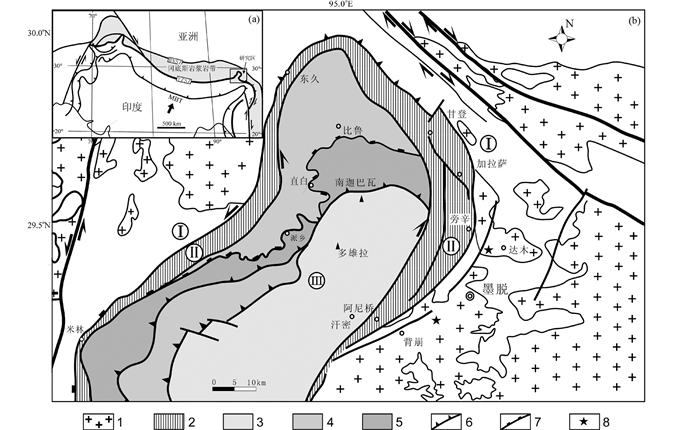
|
图 1 南迦巴瓦构造结地质简图及采样位置(据许志琴等,2008;Xu et al., 2012, 修改) Ⅰ-拉萨地体;Ⅱ-雅鲁藏布缝合带;Ⅲ-南迦巴瓦构造结;1-冈底斯花岗岩带;2-雅鲁藏布江缝合带(含蛇绿岩和混杂堆积);3-多雄拉组混合岩化角闪岩相变质岩;4-派乡组角闪岩相变质岩;5-直白组高压麻粒岩相带;6-逆冲断裂;7-拆离断裂;8-采样位置 Fig. 1 Geological sketch map of the Namche Barwa Syntaxis (after Xu et al., 2008, 2012) Ⅰ-Lhasa terrain; Ⅱ-Indus-Yarlung Tsangpo suture; Ⅲ-Namche Barwa Syntaxis; 1-Gangdese granitic belt; 2-Indus-Yarlung Tsangpo suture (containing ophiolite and mélange); 3-migmatitic amphibolites facies (Duoxiongla Formation); 4-amphibolites facies (Paixiang Formation); 5-high-pressure granulite facies (Zhibai Formation); 6-ductile thrust; 7-ductile detachment; 8-sampling position |
本文所研究的花岗岩采自墨脱县城南约15km的背崩岩体和北约25km的达木岩体(图 1b),紧邻雅鲁藏布江缝合带分布。两个花岗岩体野外特征较为相似,样品均为粗-中细粒半自形结构,块状构造,总体颜色较浅。经过显微镜详细鉴定,岩石主要矿物为:斜长石(35%~40%)、石英(20%~30%)、钾长石(30%~35%), 次要矿物为黑云母(5%~10%) 和少量白云母(<5%)。斜长石呈板状或柱状,聚片双晶发育;石英多呈他形粒状;钾长石呈板状,格子双晶明显;黑云母呈片状,多色性清楚(图 2)。副矿物主要为锆石、榍石、磁铁矿等。
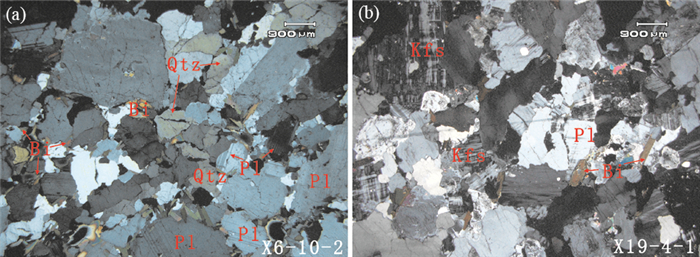
|
图 2 样品显微照片 (a)-背崩花岗岩体;(b)-达木花岗岩体.矿物代号:Qtz-石英;Pl-斜长石;Kfs-钾长石;Bi-黑云母 Fig. 2 Microphotograph of samples (a)-Beibeng granite; (b)-Damu granite. Mineral symbols: Qtz-quartz; Pl-plagioclase; Kfs-K-feldspar; Bi-biotite |
用于锆石年代学测试的代表性样品首先经过破碎,经浮选和电磁选等方法挑选出单颗粒锆石,然后在双目镜下挑纯,选样工作在河北省廊坊市大山地质矿业有限公司完成。手工挑出晶形完好、透明度和色泽度好的锆石,粘于环氧树脂表面,经抛光后进行透射光和反射光照相,在原位分析之前,通过双目镜和阴极发光(CL) 图像详细研究锆石的晶体形貌和内部结构特征,以选择同位素分析的最佳点。CL图像是在北京锆年领航科技有限公司电子探针实验室采用扫描电镜完成,加速电压为15kV。最后根据CL图像选择典型的岩浆锆石进行LA-MC-ICP-MS测年分析。本次锆石U-Pb同位素测年分析在中国地质大学(武汉) 地质过程与矿产资源国家重点实验室完成。分析仪器为Geolas2005激光剥蚀系统和Agilent7500a电感耦合等离子质谱仪(ICP-MS),激光束斑直径为32μm。详细的仪器操作条件和数据处理方法见Liu et al.(2010a, b)。采用ICPMSDataCal8.3软件对样品的同位素比值和U-Pb表面年龄数据进行处理,并利用Andersen (2002)方法对普通Pb进行校正。锆石U-Pb年龄计算及谐和图均采用ISOPLOT 3.0 (Ludwig, 2003) 程序完成。测试结果见表 1。
|
|
表 1 背崩花岗岩体(样品X6-10-2) 和达木花岗岩体(样品X19-4-1) LA-MC-ICP-MS锆石U-Pb年龄数据 Table 1 LA-MC-ICP-MS U-Pb analytical results for zircons from Beibeng granite (sample X6-10-2) and Damu granite (sample X19-4-1) |
将新鲜样品进行无污染碎样至200目,粉末送至国土资源部国家实验测试中心进行主量及微量元素测试。主量元素通过XRF (X荧光光谱仪3080E) 方法测试,分析精度为5%。微量元素和稀土元素(REE) 通过等离子质谱仪(ICP-MS-Excell) 分析,含量大于10×10-6的元素的测试精度为5%,而小于10×10-6的元素精度为10%。个别在样品中含量低的元素,测试误差大于10%。分析结果见表 2。
|
|
表 2 背崩花岗岩体和达木花岗岩体地球化学组成(主量元素:wt%;稀土和微量元素:×10-6) Table 2 Whole-rock geochemical composition of Beibeng granite and Damu granite (Major elements: wt%; Trace elements: ×10-6) |
锆石原位Hf同位素测试在中国地质科学院矿产资源研究所国土资源部成矿作用与资源评价重点实验室完成,使用的仪器为Neptune多接收等离子质谱和Newwave UP213紫外激光剥蚀系统(LA-MC-ICP-MS),实验过程中采用He作为剥蚀物质载气,剥蚀直径采用45~65μm,测试时使用锆石国际标样GJ-1作为参考物质,分析点与U-Pb定年分析点为同一位置或相邻位置。相关仪器运行条件及详细分析流程见侯可军等(2007)。测试结果见表 3。
|
|
表 3 背崩花岗岩体(样品X6-10-2) 和达木花岗岩体(样品X19-4-1) 锆石Hf年龄数据 Table 3 Hf analytical results for zircons from Beibeng granite (sample X6-10-2) and Damu granite (sample X19-4-1) |
分别对两个岩体(样品X6-10-2取自背崩花岗岩体,样品X19-4-1取自达木花岗岩体) 开展锆石U-Pb定年工作。样品X6-10-2中的锆石多为长柱状的自形晶形,长宽比为1.5:1~4:1。CL图像显示大多数锆石可见清楚的振荡环带特征,个别可见较窄的强阴极发光边(如图 3(a1) 中4测点),应为后期变质作用的结果。全部20个测点中14个测点的Th和U含量分别为498×10-6~2486×10-6和1570×10-6~9407×10-6,对应的Th/U比值介于0.25~0.44之间,锆石的结构和Th/U比值均表明其为典型的岩浆锆石(Hoskin and Schaltegger, 2003),这14个测点显示的206Pb/238U年龄范围为60.3~68.9Ma,在置信度95%时的206Pb/238U加权平均年龄值为64.5±1.3Ma (MSWD=2.6)(图 3(a2)),代表了背崩花岗岩体的形成时代。样品X19-4-1中的锆石显示长柱状自形晶形,长宽比为2.5:1~7:1,CL图像显示清楚的生长韵律或振荡环带(图 3(b1))。9个测点的Th和U含量分别为163×10-6~1862×10-6和2760×10-6~5734×10-6,对应的Th/U比值介于0.05~0.45之间,锆石的结构及Th/U比值均表明其应为岩浆锆石(Hoskin and Schaltegger, 2003),这9个测点显示的206Pb/238U年龄范围为60.4~66.7Ma,在置信度95%时的206Pb/238U加权平均年龄值为62.0±1.4Ma (MSWD=3.3)(图 3(b2)),代表了达木花岗岩体的形成时代。
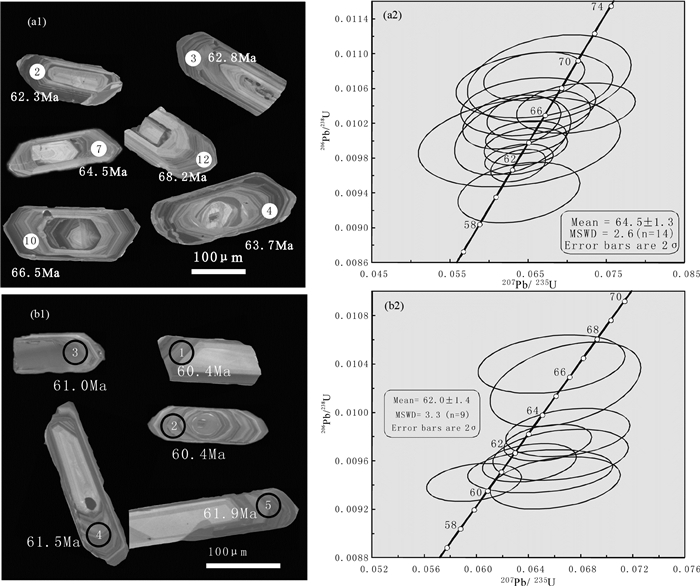
|
图 3 样品锆石阴极发光(CL) 图像及U-Pb年龄 Fig. 3 CL images and U-Pb ages of zircons from samples |
地球化学数据显示,背崩花岗岩体和达木花岗岩体具有较为一致的特征。主量元素特征表现为(表 2):SiO2含量较高,介于71.09%~74.37%之间,Al2O3含量介于13.2%~14.09%,与Na2O (2.97%~3.7%) 相比,K2O的含量(1.38%~5.93%) 变化范围较大。根据Irvine and Baragar (1971)的划分方法,样品均落在亚碱性系列范围内(图 4a);进一步根据SiO2-K2O协变图解(图 4b),样品总体表现为高钾钙碱性系列,K2O/Na2O比值介于1.52~2.0,只有X6-10-2的K2O含量较低,落入中钾拉斑系列,K2O/Na2O比值为0.37。铝饱和指数(A/CNK) 为1.01~1.02,属过铝质花岗岩(图 5)。样品的MgO含量较低(0.23%~1.16%),Mg#介于31.5~42.5。主量元素协变图解中(图 6),随着SiO2含量的变化,Al2O3、TiO2、MgO、FeO、CaO及Na2O具有较好的线性关系。
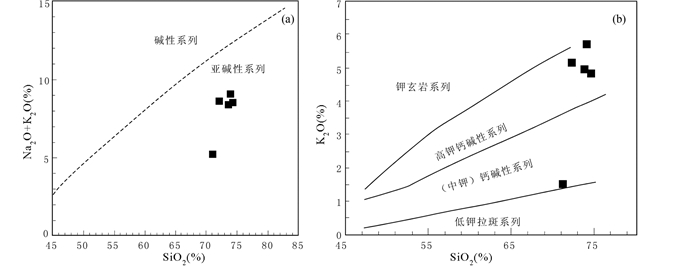
|
图 4 TAS系列划分图解(a, 据Irvine and Baragar, 1971) 和K2O-Si2O图(b, 据Rickwood,1989) Fig. 4 Diagram of TAS series (Irvine and Baragar, 1971) and plot of K2O vs. Si2O (Rickwood,1989) |
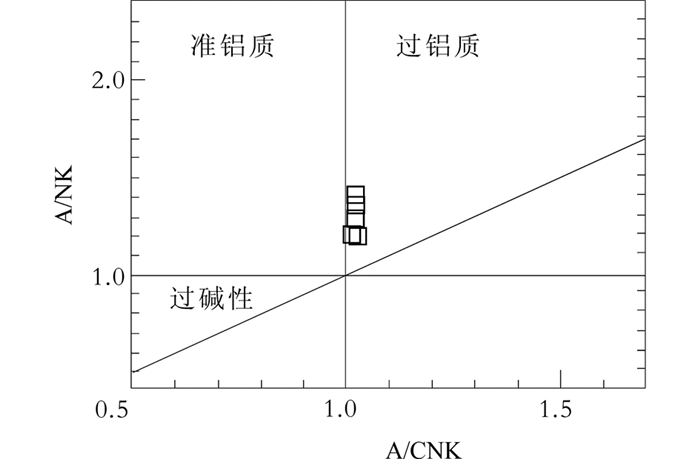
|
图 5 A/NK-A/CNK图解(据Maniar and Piccoli, 1989) Fig. 5 Plot of A/NK vs A/CNK (after Maniar and Piccoli, 1989) |
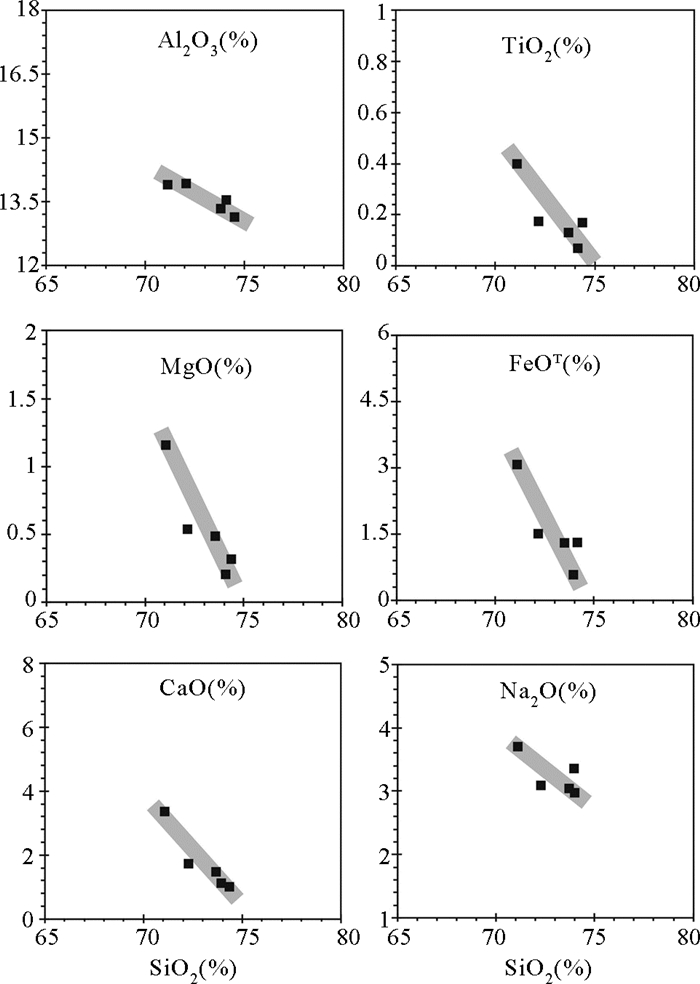
|
图 6 主量元素图解 Fig. 6 Plots of selected major element oxides vs. SiO2 |
微量元素特征表现为(表 2):富Sr (274×10-6~391×10-6)、Ba (199×10-6~1179×10-6)、Zr (97.7×10-6~170×10-6) 及Rb (62.6×10-6~151×10-6),含较低的Y (<8.3×10-6)、Yb (<0.8×10-6)、Nb (<11.2×10-6)、Hf (<5.2×10-6)、Ta (<0.83×10-6)、Th (<12.5×10-6) 及U (<2.8×10-6),Nb/Ta比值在9.41~27.43之间,Rb/Sr比值在0.19~0.39之间,高Sr/Y (40.56~83.89) 和La/Yb (23.45~70.28),即在微量元素原始地幔标准化图解中,样品明显富集大离子亲石元素(LILE),亏损高场强元素(HFSE)(图 7b)。
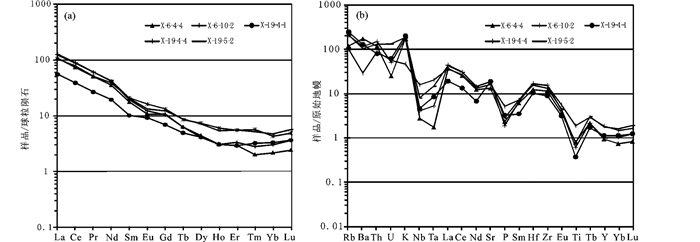
|
图 7 稀土球粒陨石标准化配分曲线图(a) 和微量元素原始地幔标准化配分曲线图(b)(标准化值据Sun and McDonough, 1989) Fig. 7 Chondrite-nomalized REE patterns (a) and primitive mantle-normalized trace element patterns (b) (normalization values after Sun and McDonough, 1989) |
稀土元素特征表现为(表 2):稀土元素球粒陨石标准化图解中,样品显示出强烈的轻、重稀土分异((La/Yb)N=16.82~50.41),轻稀土元素富集((La/Dy)N=13.55~31.30),重稀土元素亏损,但从Ho到Lu稀土元素分布样式平坦((Ho/Yb)N=0.93~1.42),δEu主要介于0.78~1.09,总体上具有正-微弱负异常(表 2、图 7a)。
4.3 锆石Hf同位素在上述两样品(X-10-2和X19-4-1) 定年的锆石中,18颗锆石进行锆石Hf同位素测定(表 3)。它们的176Yb/177Hf和176Lu/177Hf值分别为0.043157~0.151218和0.000854~0.003849。背崩花岗岩体和达木花岗岩体均具有不均一的Hf同位素组成,其εHf(t) 值变化范围较大,为-11.22~4.87(图 8),模式年龄变化范围为552~1179Ma,平均地壳模式年龄为823~1852Ma。
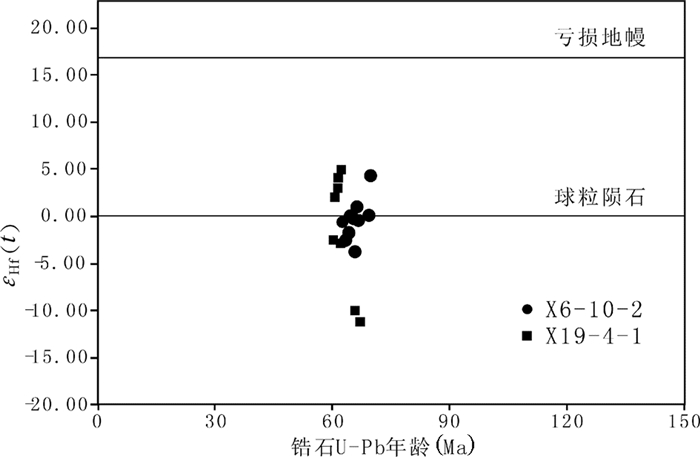
|
图 8 εHf(t)-年龄图解 Fig. 8 Plot of εHf(t) vs. ages |
从矿物组成来看,墨脱地区背崩花岗岩体和达木花岗岩体主要由石英、斜长石、钾长石、黑云母及少量白云母等组成。从地球化学特征来看,两岩体均属于高钾钙碱性系列岩石,其主量元素具有高SiO2(71.09%~74.37%),富K2O (1.38%~5.93%),K2O/Na2O比值多数大于1,低铁(TFeO<3.1%)、镁(MgO<1.2%),A/CNK=1.01~1.02,属过铝质花岗岩(图 5)。稀土元素表现为富集LREE,亏损HREE,从Ho至Lu含量变化不大,近乎平坦分布(图 7a),说明石榴石和角闪石以残留相存在(Rollison, 1993;Halyard et al., 2000);Eu具有正-微弱负异常(δEu=0.78~1.09)(图 7a),表明岩浆上升的过程中未发生明显的斜长石分离结晶作用。微量元素表现为高Ba、Sr/Y,La/Yb,低Y,Mg#(<45)、Rb/Sr,亏损HFSE元素(Nb、Ti、Zr),并且在Sr/Y-Y和La/Yb-Yb图解中(图 9),墨脱花岗岩所有样品均落在埃达克质岩石的区域内。
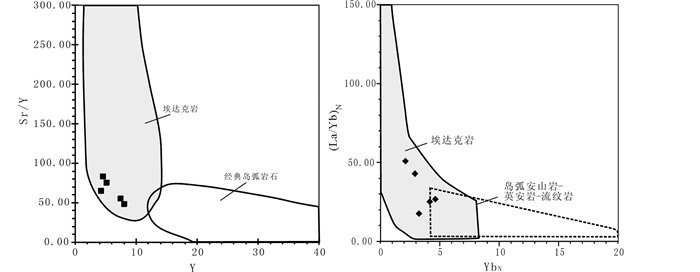
|
图 9 Sr/Y-Y图解(据Defant and Drummond, 1990) 和(La/Yb)N-YbN图解(据Martin, 1986) Fig. 9 Sr/Y vs. Y diagram (after Defant and Drummond, 1990) and (La/Yb)N vs. YbN diagram (after Martin, 1986) |
一般认为埃达克质岩石具有以下地球化学特征:SiO2含量≥56%,Al2O3≥15%, 亏损Y (≤18×10-6) 和重稀土元素(HREE)(如Yb≤1.9×10-6), 高Sr (很少<400×10-6), 无或正Eu异常, 贫高场强元素(HFSE)(王强等,2008)。墨脱地区花岗岩虽然具有类似埃达克岩的地球化学特征,但与典型的埃达克岩不完全一致:K2O/Na2O比值较高,但是Sr=274×10-6~391×10-6、Al2O3=13.2%~14.09%(均<15%),均低于典型埃达克岩(高Sr很少<400×10-6、Al2O3≥15%);Mg#介于31.5~42.5,明显低于埃达克岩的均值Mg#(51)。
综上,墨脱地区背崩花岗岩体和达木花岗岩体具有类埃达克岩的地球化学特征,但并非典型的埃达克岩。岩体高硅、富钾,属于过铝质、高钾钙碱性系列,具有高Sr/Y花岗岩岩石地球化学特征。
5.2 岩浆源区及地球动力学背景墨脱高Sr/Y花岗岩的锆石Hf同位素组成有较大的变化范围,εHf(t) 值得变化范围为-11.22~4.87 (变化范围达16个ε单位),单阶段Hf模式年龄变化范围为552~1179Ma,显示了该区花岗岩锆石颗粒Hf同位素组成的不均一性, 由于锆石Hf同位素比值不会随部分熔融或分离结晶作用变化, 因此锆石Hf同位素的不均一性很可能指示了更具放射成因Hf的幔源和有较少放射成因Hf的壳源这两种端元之间的混合作用(Bolhar et al., 2008;朱弟成等,2009)。在主量元素图解(图 6) 中,墨脱高Sr/Y花岗岩的SiO2与Al2O3、TiO2、MgO、FeO、CaO及Na2O等呈良好的线性关系,这是岩浆混合作用区分于岩浆分离结晶作用的一个重要特征。
锆石饱和温度(Miller et al., 2003) 计算表明,形成墨脱高Sr/Y花岗岩的母岩浆具有较高温度(746~791℃)(表 2),明显高于北喜马拉雅中新世淡色花岗岩(Zhang et al., 2004),与有幔源物质参与的华南佛冈花岗岩具有较为一致的特征(Li et al., 2007),结合上述锆石Hf同位素数据表明,幔源物质很可能在墨脱高Sr/Y花岗岩的形成过程中起到重要作用。已有资料表明,在冈底斯岩浆岩带中部分布大面积与墨脱高Sr/Y花岗岩同期的碰撞-后碰撞岩浆岩,即新生代林子宗火山岩与过铝质花岗岩,其形成时代为40.84~64.47Ma (其中典中组火山岩形成于60.60~64.47Ma),并且全岩εNd介于3~-5之间(莫宣学等,2003),Nd-Sr-Pb同位素均指示地幔与地壳、海洋地幔与大陆地幔相互作用的信息, 暗示着从新特提斯洋俯冲体制向大陆碰撞体制转变的地球动力学环境。由此可见,墨脱花岗岩与林子宗火山岩具有很好的可比性,即在新特提斯洋板块俯冲过程产生的基性岩浆,不断上升聚集在Moho附近陆壳底部,到俯冲结束、大陆开始碰撞时,底侵基性岩浆已达到相当规模,所积聚的热量已足以使陆壳发生熔融,从而产生大面积的酸性岩浆,可以较好地解释墨脱高Sr/Y花岗岩所显示的壳幔物质混合信息。
6 结论通过对墨脱高Sr/Y花岗岩的岩石地球化学、锆石U-Pb年代学及Hf同位素研究,本文得出以下几点认识:
(1) 南迦巴瓦构造结墨脱地区广泛发育新生代岩浆作用,锆石U-Pb定年结果显示其背崩花岗岩体和达木花岗岩体的侵位时代分别为64.5±1.3Ma和62.0±1.4Ma;
(2) 墨脱高Sr/Y花岗岩具有高SiO2、富K2O和低FeO、MgO特征,属于过铝质、高钾钙碱性系列岩石,富集LREE,亏损HREE,正-微弱负Eu异常,具较高Ba、Sr/Y,La/Yb和低Y,Mg#(<45)、Rb/Sr,亏损HFSE元素(Nb、Ti、Zr),锆石Hf同位素组成的不均一性(εHf(t) 介于-11.22~4.87之间) 反映了其形成时的物源特征较为复杂;
(3) 墨脱高Sr/Y花岗岩可能是在印度-亚洲大陆碰撞阶段,由新特提斯洋俯冲过程中产生的基性岩浆底侵作用使陆壳熔融并发生壳幔岩浆混合作用所形成。
致谢 锆石U-Pb定年测试在中国地质大学(武汉) 地质过程与矿产资源国家重点实验室完成,测试和分析过程中得到胡兆初教授的帮助;全岩地球化学测试由国家地质实验测试中心完成;锆石Hf同位素测试在中国地质科学院矿产资源研究所国土资源部成矿作用与资源评价重点实验室完成,得到郭春丽和侯可军的帮助;承蒙吴才来研究员和戚学祥研究员对本文的细致审阅并提出富有建设性的意见和建议;在此一并表示衷心的感谢。| [] | Andersen T. 2002. Correction of common Pb in U-Pb analyses that do not report 204Pb. Chemical Geology, 192(1-2): 59–79. DOI:10.1016/S0009-2541(02)00195-X |
| [] | Bolhar R, Weaver SD, Whitehouse MJ, Palin JM, Woodhead JD, Cole JW. 2008. Sources and evolution of arc magmas inferred from coupled O and Hf isotope systematic of plutonic zircons from the Cretaceous Separation Point Suite (New Zealand). Earth and Planet Science Letters, 268(3-4): 312–324. DOI:10.1016/j.epsl.2008.01.022 |
| [] | Booth AL, Zeitler PK, Kidd WSF, Wooden J, Liu YP, Idleman B, Hren M, Chamberlain CP. 2004. U-Pb zircon constraints on the tectonic evolution of southeastern Tibet, Namche Barwa area. American Journal of Science, 304(10): 889–929. DOI:10.2475/ajs.304.10.889 |
| [] | Chiu HY, Chung SL, Wu FY, Liu DY, Liang YH, Lin IJ, Iizuka Y, Xie LW, Wang YB, Chu MF. 2009. Zircon U-Pb and Hf isotope constraints from eastern Transhimalayan batholiths on the precollisional magmatic and tectonic evolution in southern Tibet. Tectonophysics, 477(1-2): 3–19. DOI:10.1016/j.tecto.2009.02.034 |
| [] | Chu MF, Chung SL, Song B, Liu DY, O'Reilly SY, Pearson NJ, Ji JQ, Wen DR. 2006. Zircon U-Pb and Hf isotope constraints on the Mesozoic tectonics and crustal evolution of southern Tibet. Geology, 34(9): 745–748. DOI:10.1130/G22725.1 |
| [] | Chung SL, Chu MF, Zhang YQ, Xie YW, Lo CH, Lee HY, Lan CY, Li XH, Zhang Q, Wang YZ. 2005. Tibetan tectonic evolution inferred from spatial and temporal variations in post-collisional magmatism. Earth Science Reviews, 68(3-4): 173–196. |
| [] | Defant MJ, Drummond MS. 1990. Derivation of some modern arc magmas by melting of young subducted lithosphere. Nature, 347(6294): 662–665. DOI:10.1038/347662a0 |
| [] | Ding L, Zhong DL, Yin A, Kapp P, Harrison TM. 2001. Cenozoic structural and metamorphic evolution of the eastern Himalayan syntaxis (Namche Barwa). Earth and Planet Science Letters, 192(3): 423–438. DOI:10.1016/S0012-821X(01)00463-0 |
| [] | Ding L, Kapp P, Wan XQ. 2005. Paleocene-Eocene record of ophiolite obduction and initial India-Asia collision, south central Tibet. Tectonic, 24(3). DOI:10.1029/2004TC001729 |
| [] | Dong GC, Mo XX, Zhao ZD, Guo TY, Wang LL, Chen T. 2005. Geochronologic constraints on the magmatic underplating of the Gangdisê Belt in the India-Eurasia collision: Evidence of SHRIMP II zircon U-Pb dating. Acta Geologica Sinica, 79(6): 787–794. DOI:10.1111/acgs.2005.79.issue-6 |
| [] | Dong GC, Mo XX, Zhao ZD, Zhu DC, Wang LL, Chen T, Li B. 2006. Magma mixing in middle part of Gangdise magma belt: Evidences from granitoid complex. Acta Petrologica Sinica, 22(4): 835–844. |
| [] | Guan Q, Zhu DC, Zhao ZD, Zhang LL, Liu M, Li XW, Yu F, Mo XX. 2010. Late Cretaceous adakites in the eastern segment of the Gangdese Belt, southern Tibet: Products of Neo-Tethyan ridge subduction?. Acta Petrologica Sinica, 26(7): 2165–2179. |
| [] | Halyard M, Nielsen RL, Beard JS, Patinõ-Douce A, Blencoe J. 2000. Experimental determination of the partitioning behavior of rare earth and high field strength elements between pargasitic amphibole and natural silicate melts. Geochimica et Cosmochimica Acta, 64(6): 1103–1120. DOI:10.1016/S0016-7037(99)00379-8 |
| [] | Hoskin PWO, Schaltegger U. 2003. The composition of zircon and igneous and metamorphic petrogenesis. In: Manchar JM and Hoskin PWO (eds.). Zircon. Reviews of Mineralogy and Geochemistry, 53(1): 27–62. DOI:10.2113/0530027 |
| [] | Hou KJ, Li YH, Zou TR, Qu XM, Shi YR, Xie GQ. 2007. Laser ablation-MC-ICP-MS technique for Hf isotope microanalysis of zircon and its geological applications. Acta Petrologica Sinica, 23(10): 2595–2604. |
| [] | Irvine TN, Baragar WRA. 1971. A guide to the chemical classification of the common volcanic rocks. Canadian Journal of Earth Sciences, 8(5): 523–548. DOI:10.1139/e71-055 |
| [] | Ji WQ, Wu FY, Chung SL, Li JX, Liu CZ. 2009. Zircon U-Pb geochronology and Hf isotopic constraints on petrogenesis of the Gangdese batholiths, southern Tibet. Chemical Geology, 262(3-4): 229–245. DOI:10.1016/j.chemgeo.2009.01.020 |
| [] | Jiang W, Mo XX, Zhao CH, Guo TY, Zhang SQ. 1999. Geochemistry of granitoid and its mafic microgranular enclave in Gangdise belt, Qinghai-Xizang Plateau. Acta Petrologica Sinica, 15(1): 89–97. |
| [] | Lee HY, Chung SL, Wang YB, Zhu DC, Yang JY, Song B, Liu DY, Wu FY. 2007. Age, petrogenesis and geological significance of the Linzizong volcanic successions in the Linzhou basin, southern Tibet: Evidence from zircon U-Pb dates and Hf isotopes. Acta Petrologica Sinica, 23(2): 493–500. |
| [] | Li XH, Li ZX, Li WX, Liu Y, Yuan C, Wei GJ, Qi CS. 2007. U-Pb zircon geochemical and Sr-Nd-Hf isotopic constraints on age and origin of Jurassic I-and A-type granites from central Guangdong, SE China: A major igneous event in response to foundering of a subducted flat slab. Lithos, 96(1-2): 186–204. DOI:10.1016/j.lithos.2006.09.018 |
| [] | Liang YH, Chung SL, Liu DY, Xu YG, Wu FY, Yang JH, Wang YB, Lo TH. 2008. Detrital zircon evidence from Burma for reorganization of the eastern Himalayan river system. American Journal of Science, 308(4): 618–638. DOI:10.2475/04.2008.08 |
| [] | Liu YS, Gao S, Hu ZC, Gao CG, Zong KQ, Wang DB. 2010a. Continental and oceanic crust recycling-induced melt-peridotite interactions in the Trans-North China Orogen: U-Pb dating, Hf isotopes and trace elements in zircons from mantle xenoliths. Journal of Petrology, 51(1-2): 537–571. DOI:10.1093/petrology/egp082 |
| [] | Liu YS, Hu ZC, Zong KQ, Gao CG, Gao S, Xu J, Chen HH. 2010b. Reappraisement and refinement of zircon U-Pb isotope and trace element analyses by LA-ICP-MS. Chinese Science Bulletin, 55(15): 1535–1546. DOI:10.1007/s11434-010-3052-4 |
| [] | Ludwig KR. 2003. ISOPLOT 3. 00: A Geochronological Toolkit for Microsoft Excel. Berkeley Geochromology Center Special Publication. |
| [] | Maniar PD, Piccoli PM. 1989. Tectonic discrimination of granitoids. Geological Society of America Bulletin, 101(5): 635–643. DOI:10.1130/0016-7606(1989)101<0635:TDOG>2.3.CO;2 |
| [] | Matin H. 1986. Effect of steeper Archean geothermal gradient on geochemistry of subduction-zone magmas. Geology, 14: 753–756. DOI:10.1130/0091-7613(1986)14<753:EOSAGG>2.0.CO;2 |
| [] | Miller CF, McDowell SM, Mapes RW. 2003. Hot and cold granites? Implications of zircon saturation temperatures and preservation of inheritance. Geology, 31(6): 529–532. DOI:10.1130/0091-7613(2003)031<0529:HACGIO>2.0.CO;2 |
| [] | Mo XX, Zhao ZD, Deng JF, Dong GC, Zhou S, Guo TY, Zhang SQ, Wang LL. 2003. Response of volcanism to the India-Asia collision. Earth Science Frontiers, 10(3): 135–148. |
| [] | Mo XX, Dong GC, Zhao ZD, Guo TY, Wang LL, Chen T. 2005. Timing of magma mixing in the Gangdisê magmatic belt during the India-Asia collision: Zircon SHRIMP U-Pb dating. Acta Geologica Sinica, 79(1): 66–76. DOI:10.1111/acgs.2005.79.issue-1 |
| [] | Mo XX, Hou ZQ, Niu YL, Dong GC, Qu XM, Zhao ZD, Yang ZM. 2007. Mantle contributions to crustal thickening during continental collision: Evidence from Cenozoic igneous rocks in southern Tibet. Lithos, 96(1-2): 225–242. DOI:10.1016/j.lithos.2006.10.005 |
| [] | Mo XX, Zhao ZD, Zhu DC, Yu XH, Dong GC, Zhou X. 2009. On the lithosphere of Indo-Asia collision zone in southern Tibet: Petrological and geochemical constraints. Earth Science, 34(1): 17–27. |
| [] | Pan GT, Ding J, Wang LQ. 2004. Geological Map (1:1500000) of Qinghai-Xizang (Tibetan) Plateau and Adjacent Areas. Chengdu: Chengdu Cartographic Publishing House. |
| [] | Pan GT, Mo XX, Hou ZQ, Zhu DC, Wang LQ, Li GM, Zhao ZD, Geng QR, Liao ZL. 2006. Spatial-temporal framework of the Gangdese Orogenic Belt and its evolution. Acta Petrologica Sinica, 22(3): 521–533. |
| [] | Qi XX, Li TF, Li HQ, Cai ZH, Yu CL. 2010. Zircon SHRIMP U-Pb dating for garnet-rich granite veins in high-pressure granulites from the Namche Barwa complex, eastern syntaxis of the Himalaya, and the relationship with exhumation. Acta Petrologica Sinica, 26(3): 75–984. |
| [] | Ravikant V, Wu FY, Ji WQ. 2009. Zircon U-Pb and Hf isotopic constraints on petrogenesis of the Cretaceous-Tertiary granites in eastern Karakoram and Ladakh, India. Lithos, 110(1-4): 153–166. DOI:10.1016/j.lithos.2008.12.013 |
| [] | Rickwood PC. 1989. Boundary lines within petrologic diagrams which use oxides of major and minor elements. Lithos, 22(4): 247–263. DOI:10.1016/0024-4937(89)90028-5 |
| [] | Rollison HR. 1993. Using Geochemical Data: Evaluation, Presentation, Interpretation. New York: Longman Scientific & Technical Limited: 113–121. |
| [] | Schärer U, Xu RH, Allègre CJ. 1984. U-Pb geochronology of Gangdese (Transhimalaya) plutonism in the Lhasa-Xigaze region, Tibet. Earth and Planetary Science Letters, 69(2): 311–320. DOI:10.1016/0012-821X(84)90190-0 |
| [] | Seward D, Burg JP. 2008. Growth of the Namche Barwa Syntaxis and associated evolution of the Tsangpo Gorge: Constraints from structural and thermochronological data. Tectonophysics, 451(1-4): 282–289. DOI:10.1016/j.tecto.2007.11.057 |
| [] | Sun SS, McDonough WF. 1989. Chemical and isotopic systematics of oceanic basalts: Implications for mantle composition and processes. In: Saunders AD and Norry MJ (eds.). Magmatism in Oceanic Basins. Geological Society, London, Special Publications, 42(1): 313–345. DOI:10.1144/GSL.SP.1989.042.01.19 |
| [] | Wang Q, Xu JF, Zhao ZH, Zi F, Tang GJ, Jia XH, Jiang ZQ. 2008. Tectonic setting and associated rock suites of adakitic rocks. Bulletin of Mineralogy, Petrology and Geochemistry, 27(4): 344–350. |
| [] | Wen DR, Chung SL, Song B, Iizuka Y, Yang HJ, Ji JQ, Liu DY, Gallet S. 2008. Late cretaceous Gangdese intrusions of adakitic geochemical characteristics, SE Tibet: Petrogenesis and tectonic implications. Lithos, 105(1-2): 1–11. DOI:10.1016/j.lithos.2008.02.005 |
| [] | Xu RH, Schärer U, Allègre CJ. 1985. Magmatism and metamorphism in the Lhasa Block (Tibet): A geochronological study. Journal of Petrology, 93(1): 41–57. |
| [] | Xu ZQ, Cai ZH, Zhang ZM, Li HQ, Chen FY, Tang ZM. 2008. Tectonics and fabric kinematics of the Namche Barwa terrane, Eastern Himalayan Syntaxis. Acta Petrologica Sinica, 24(7): 1463–1476. |
| [] | Xu ZQ, Ji SC, Cai ZH, Zeng LS, Geng QR, Cao H. 2012. Kinematics and dynamics of the Namche Barwa Syntaxis, eastern Himalaya: Constraints from deformation, fabrics and geochronology. Gondwana Research, 21(1): 19–36. DOI:10.1016/j.gr.2011.06.010 |
| [] | Yin A, Harrison TM. 2000. Geologic evolution of the Himalayan-Tibetan Orogen. Annual Review of Earth and Planetary Sciences, 28(1): 211–280. DOI:10.1146/annurev.earth.28.1.211 |
| [] | Zhang HF, Harris N, Parrish R, Kelley S, Zhang L, Rogers N, Argles T, King J. 2004. Causes and consequences of protracted melting of the mid-crust exposed in the North Himalayan antiform. Earth and Planetary Science Letters, 228(1-2): 195–212. DOI:10.1016/j.epsl.2004.09.031 |
| [] | Zhang ZM, Wang JL, Dong X, Zhao GC, Yu F, Wang W, Liu F, Geng GS. 2009. Petrology and geochronology of the charnockite from the southern Gangdese belt, Tibet: Evidence for the Andean-type orogen. Acta Petrologica Sinica, 25(7): 1707–1720. |
| [] | Zhang ZM, Zhao GC, Santosh M, Wang JL, Dong X, Shen K. 2010. Late Cretaceous charnockite with adakitic affinities from the Gangdese batholith, southeastern Tibet: Evidence for Neo-Tethyan mid-ocean ridge subduction. Gondwana Research, 17(4): 615–631. DOI:10.1016/j.gr.2009.10.007 |
| [] | Zheng LL, Jin ZM, Pan GT, Geng QR, Sun ZM. 2004. Geological features and tectonic evolution in the Namjagbarwa area, Eastern Himalayas. Acta Geologica Sinica, 78(6): 744–751. |
| [] | Zhu DC, Pan GT, Mo XX, Wang LQ, Liao ZL, Zhao ZD, Dong GC, Zhou CY. 2006. Late Jurassic-Early Cretaceous geodynamic setting in middle-northern Gangdese: New insights from volcanic rocks. Acta Petrologica Sinica, 22(3): 534–546. |
| [] | Zhu DC, Pan GT, Wang LQ, Mo XX, Zhao ZD, Zhou CY, Liao ZL, Dong GC, Yuan SH. 2008. Tempo-spatial variations of Mesozoic magmatic rocks in the Gangdise belt, Tibet, China, with a discussion of geodynamic setting-related issues. Geological Bulletin of China, 27(9): 1535–1550. |
| [] | Zhu DC, Mo XX, Wang LQ, Zhao ZD, Niu YL, Zhou CY, Yang YH. 2009. Petrogenesis of highly fractionated I-type granites in the Zayu area of eastern Gangdese, Tibet: Constraints from zircon U-Pb geochronology, geochemistry and Sr-Nd-Hf isotopes. Science in China (Series D), 52(9): 1223–1239. DOI:10.1007/s11430-009-0132-x |
| [] | 董国臣, 莫宣学, 赵志丹, 朱弟成, 王亮亮, 陈涛, 李冰. 2006. 冈底斯岩浆带中段岩浆混合作用:来自花岗杂岩的证据. 岩石学报, 22(4): 835–844. |
| [] | 管琪, 朱弟成, 赵志丹, 张亮亮, 刘敏, 李小伟, 于枫, 莫宣学. 2010. 西藏南部冈底斯带东段晚白垩世埃达克岩:新特提斯洋脊俯冲的产物. 岩石学报, 26(7): 2165–2179. |
| [] | 侯可军, 李延河, 邹天人, 曲晓明, 石玉若, 谢桂青. 2007. LA-MC-ICP-MS锆石Hf同位素的分析方法及地质应用. 岩石学报, 23(10): 2595–2604. |
| [] | 江万, 莫宣学, 赵崇贺, 郭铁鹰, 张双全. 1999. 青藏高原冈底斯带中段花岗岩类及其中铁镁质微粒包体地球化学特征. 岩石学报, 15(1): 89–97. |
| [] | 李皓扬, 钟孙霖, 王彦斌, 朱弟成, 杨进辉, 宋彪, 刘敦一, 吴福元. 2007. 藏南林周盆地林子宗火山岩的时代、成因及其地质意义:锆石U-Pb年龄和Hf同位素证据. 岩石学报, 23(2): 493–500. |
| [] | 莫宣学, 赵志丹, 邓晋福, 董国臣, 周肃, 郭铁鹰, 张双全, 王亮亮. 2003. 印度-亚洲大陆主碰撞过程的火山作用响应. 地学前缘, 10(2): 135–148. |
| [] | 莫宣学, 赵志丹, 朱弟成, 喻学惠, 董国臣, 周肃. 2009. 西藏南部印度-亚洲碰撞带岩石圈:岩石学-地球化学约束. 地球科学, 34(1): 17–27. |
| [] | 潘桂棠, 丁俊, 王立全. 2004. 1:1500000青藏高原及邻区地质图及说明书. 成都: 成都地图出版社. |
| [] | 潘桂棠, 莫宣学, 侯增谦, 朱弟成, 王立全, 李光明, 赵志丹, 耿全如, 廖忠礼. 2006. 冈底斯造山带的时空结构及演化. 岩石学报, 22(3): 521–533. |
| [] | 戚学祥, 李天福, 李化启, 蔡志慧, 于春林. 2010. 东喜马拉雅构造结南迦巴瓦群高压麻粒岩中含石榴石花岗岩脉锆石SHRIMP U-Pb定年及其与折返作用. 岩石学报, 26(3): 975–984. |
| [] | 王强, 许继峰, 赵振华, 资锋, 唐功建, 贾小辉, 姜子琦. 2008. 埃达克质岩的构造背景与岩石组合. 矿物岩石地球化学通报, 27(4): 344–350. |
| [] | 许志琴, 蔡志慧, 张泽明, 李化启, 陈方远, 唐哲民. 2008. 喜马拉雅东构造结-南迦巴瓦构造及组构运动学. 岩石学报, 24(7): 1463–1476. |
| [] | 张泽明, 王金丽, 董昕, 赵国春, 于飞, 王伟, 刘峰, 耿官升. 2009. 青藏高原冈底斯带南部的紫苏花岗岩:安第斯型造山作用的证据. 岩石学报, 25(7): 1707–1720. |
| [] | 郑来林, 金振民, 潘桂棠, 耿全如, 孙志明. 2004. 东喜马拉雅南迦巴瓦地区区域地质特征及构造演化. 地质学报, 78(6): 744–751. |
| [] | 朱弟成, 潘桂棠, 莫宣学, 王立全, 廖忠礼, 赵志丹, 董国臣, 周长勇. 2006. 冈底斯中北部晚侏罗世-早白垩世地球动力学环境火山岩约束. 岩石学报, 22(3): 534–546. |
| [] | 朱弟成, 潘桂棠, 王立全, 莫宣学, 赵志丹, 周长勇, 廖忠礼, 董国臣, 袁四化. 2008. 西藏冈底斯带中生代岩浆岩的时空分布和相关问题的讨论. 地质通报, 27(9): 1535–1550. |
| [] | 朱弟成, 莫宣学, 王立全, 赵志丹, 牛耀龄, 周长勇, 杨岳衡. 2009. 西藏冈底斯东部察隅高分异I型花岗岩的成因:锆石U-Pb年代学、地球化学和Sr-Nd-Hf同位素约束. 中国科学(D辑), 39(7): 833–848. |
 2013, Vol. 29
2013, Vol. 29


